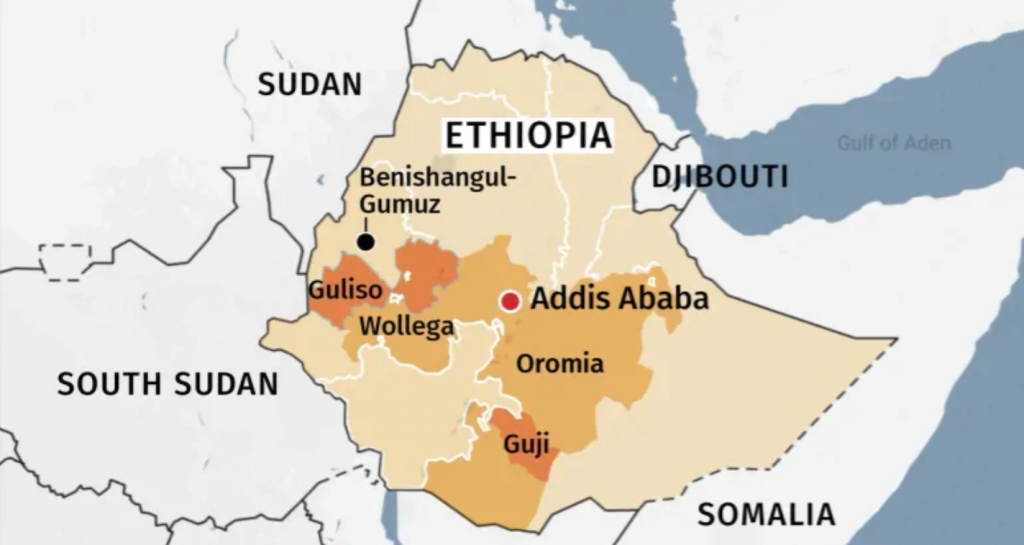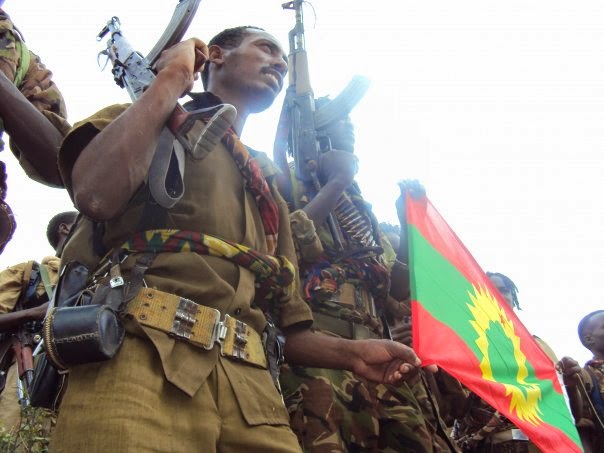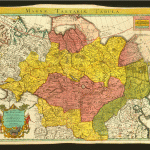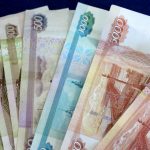On November 2 several news agencies reported that dozens of peaceful civilians were killed in West Wollega zone, Guliso Werda, Gawwa Qanqa kebele of Oromia regional state. According to the unconfirmed data victims belonged to Amhara ethnic group and were executed by “members of OLF/Shene (Ofomo Liberation Army)” rebel group.
The killings took place shortly after the evacuation of members of the federal armed forces from the area from the area unexpectedly and without explanation. The Amnesty International reported that more than 50 had died. Other source acclaim more than 150 of victims.

The federal government is engaged in an ongoing civil war with members of Oromo Liberation Army (OLA) in the area. OLA is a breakaway armed faction from the Oromo Liberation Front (OLF), but their pleas were not heard. Most parts of Wollega in western Oromia and Guji in southern Oromia are under the federal command post since two years.
Oromia regional state communication bureau blaming “OLF/Shene” and “TPLF” for attack.
Shimelis Abdissa, President of Oromia regional state also blamed TPLF for sowing the seeds of hatred between the Amhara and Oromo people. But according to him, when that didn’t work, TPLF uses “OLF/Shene” as a Trojan Horse, arming it, providing it with logistics and financial support in order to target civilians.
In 1991, the OLF joined the TPLF-led transitional government and continued to administer an area around Dembi Dollo in Western Wollega, which it had controlled in the final days of the war. Further, the OPDO and the TPLF/EPRDF use the OLF’s quixotic guerrilla campaign to justify political repression. There had been a rumor going about the relationship between OLF and TPLF. It is narrated that TPLF is influencing OLF.
Abiy can be interested in blaming TPLF to suppress Tigray’s secessionism and have a cause to intervene.
The Amhara Prosperity Party, the ruling party of Amhara regional state and a part of Abiy Ahmed’s Prosperity Party (PP), called for the National Security Council to consider the targeted attacks against members of the Amhara community in various parts of the country as “a threat to the national security.” The party also accused the TPLF group functioning from Mekelle as playing gamble on the lives of the Amhara people and the root cause of the problem.
Tension between Amhara and Tigray, two of Ethiopia’s most powerful regions, is increasing as the country approaches elections next year.
TPLF is thought to be laying the groundwork for the creation of a breakaway state and confronting Abiy government. Under Abiy Tigrayan leaders have complained of being unfairly targeted in corruption prosecutions, removed from top positions and broadly scapegoated for the country’s woes. So, TPLF’s weakening plays in favor of official Addis Ababa.
Inclusive dialogue is crucial to diffuse tensions across Ethiopia, the standoff between the federal government and the TPLF could spill over into violence. In recent days tensions have risen over who controls federal military assets in Tigray.
Ethiopian Prime Minister Abiy Ahmed enjoys only fragmented and diminishing popular support in his country. Even in his home region of Oromia, his leadership is seriously contested by the ethnonationalist forces represented by the social media activist Jawar Mohammed. On Oct. 23, when the Oromia region was shaken by a deadly wave of violence following a series of Facebook posts from Jawar. Around 70 civilians were killed when his angry supporters took to the streets, setting off an intercommunal conflict that took on an ethnic and religious dimension.
There is a power-struggle inside Oromo between Jawar and Abiy. Jawar, who says he may run in next year’s election, has loudly criticised the prime minister’s plan to form a national party to replace Ethiopia’s ruling multi-ethnic coalition.
The situation is deteriorated by competition between Oromos and Amharas. Since 1995, when the current constitution established nine ethnically based regions, politics has been a battleground between rival nationalisms. For much of the past three decades the Tigrayans, who are about 6% of the population, ran the show.
Now Oromos are in charge, which has triggered a backlash among Amharic-speakers and some minorities who fear that the Oromo nationalism espoused by Jawar and his followers could lead to marginalisation. Towns in Oromia with large Amharic-speaking populations including Adama and Addis Ababa are especially volatile.
Since moving into Ethiopia’s highlands in the 1600s, the Oromos have been discriminated against by the ruling Tigray and Amhara classes, who often saw them as “uncivilised”, according to historian John Markakis. The Oromos were largely excluded from national political power until 1991, when the Oromo Liberation Front (OLF), which was allied with other rebels, helped overthrow a military junta. Oromo Liberation Front (OLF), an opposition party returned from exile following the election of Nobel Peace Prize-winning President Abiy Ahmed, in 2018.
The roots of the present Oromo-Amhara conflict lie in the late 1800s when the independent Oromo nation was conquered by Abyssinians who were creating an empire. The Oromo have always viewed the Amhara Emperor Menelik and his successors, backed by European powers, as colonizers. His retainers acquired rights over the most productive Oromo lands and were allowed to exact tribute from even greater areas. Written Oromo texts were destroyed and education of Oromos was conducted in Amharic.
The political narratives exploited by ethno-nationalist Oromo groups were designed to pit one group against another. In particular, most ethno-nationalists wrongly accused the Amhara people, and the country’s imperial past, for what they refer to as their history of marginalization.
The ruling Amhara, who constitute less than 15 percent of the nation’s population but have ruled since the 19th century, have been systematically driving the Oromo for their fertile lands and subjecting them to torture, imprisonment, forced conscription, and execution. At least half of the more than 2.5 million refugees fleeing Ethiopia are Oromo. Contrary to the received impression, many Ethiopian refugees are not direct victims of the border dispute between Ethiopia and Somalia, but rather of internal ethnic conflict.
Oromo nationalism has served as an ideology of anti-government struggle for over half a century. Inspired by the Bale rebellion and Macha-Tulama Association, the Oromo Liberation Front (OLF) became the leading organization to fight for the Oromo cause.
For Oromo nationalists, Amhara elites were beneficiaries of the past imbalance of power, at the expense of everyone else. The Oromo, as they see it, have now set out to reverse this. On the other hand, Amhara elites see the Oromo as the new power-wielders in the country and this is perceived as a step towards further Amhara subjugation. Thus, the attempt by one to end the past power imbalance is leading to worries by the other that a new imbalance of power is in the making.
Another source of conflict between Oromo and Amkhara is the status of minorities in each other’s regions or zones. Amhara elites have concerns about their co-ethnics living in the Oromia region (and in other regional states where they are a minority). They argue that Amhara minorities have no formal political representation in the regions.
Oromo nationalism helped bring Abiy Ahmed to power, but it could also be his undoing. To hold the country together, the prime minister needs to convince various ethnic groups that he and his new party represent all Ethiopians. However, in Ethiopia today, the Prime Minister is Oromo; the Defense Minister is also Oromo, the army chief is Oromo, and the main capital city’s leader is Oromo. So, to avoid confrontation between ethnic groups in Ethiopia and government, Abiy have to save the status of ethnic peaceful coexistence guarantee by different mechanisms.





